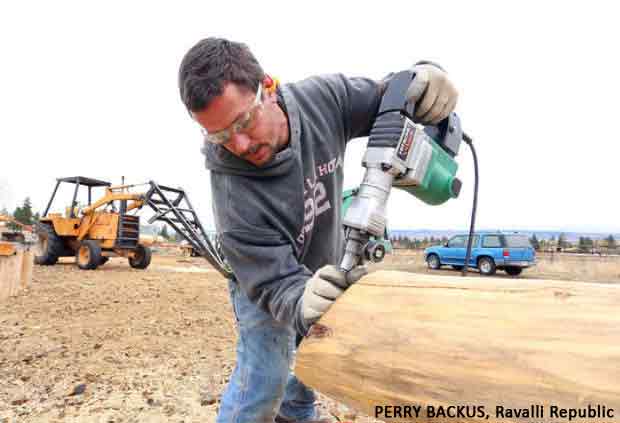 |
| Brian Perschlea of Darby works to chip out a cup that will become a handcrafted joint in a log rafter under construction at Victor's Bitterroot Valley Log and Timber. |
Missoulian • September 13, 2015 9:00 am • By Rob Chaney
New federal building guidelines have some western Montana log-home builders worried they can’t find logs big enough anymore to meet the code.
But the adviser who helped interpret the new standards for Missoula County says there’s more flexibility than many realize for energy efficient construction.
“If it goes into 14-inch logs, that will put every log home builder out of business,” said Dan Baker, co-owner of Nordique Log Homes in Condon. “It’s a non-issue anyway. Whether you have an 8-inch log or a 14-inch log, your electric bill won’t be off 50 cents.”
At issue is a new set of federal energy efficiency building codes that Montana adopted last year.
But the state only enforces electrical and plumbing codes, leaving it to counties and cities to decide local levels of enforcement.
Unlike many surrounding counties, Missoula County inspects for construction and energy efficiency standards in rural areas.
The new energy efficiency code requires log homes to have an insulation R value of 15. Assuming the average log has an R rating of about 1 point per inch, that would require logs at least 14 inches wide to meet code.
Baker and partner Ken Donovan said most builders use logs between 8 and 12 inches, because that’s the common size for preferred 100-year-old lodgepole pine trunks available locally.
Larger logs would have to be imported from Canada or the West Coast. They also claim that lodgepole, which has more air pockets than other species, has an R value closer to 1.5 per inch.
“Ninety-nine percent of conventional buildings are made with metal or wood frames, sheeting and fiberglass insulation,” Baker said. “They take that combination and calculate the R factor.
"But logs have thermal mass. From an efficiency standpoint, thermal mass is more effective than R factor. A log home is cool in summer and warm in winter.”
Dale Horton of the National Center for Appropriate Technology gave a workshop last week in Missoula reviewing the new standards. He said there were lots of misunderstandings about how rigid the rules are.
“In the most simplistic prescriptive sense, a wall would have to average 14 inches to meet the energy efficiency code,” Horton said. “But we tried to explain there are other alternative compliance paths. As long as he put in better windows or more insulation in the roof so the total, overall thermal performance of the envelope is equivalent, they can meet the code.”
County building inspectors, not NCAT, are responsible for enforcing the codes.
But Horton said he’s arranging workshops for area builders to familiarize them with the changes, many of which were initially proposed in 2012 or earlier. The energy efficiency codes are based on research developed by the log homes committee of the National Association of Home Builders.
Baker said he remains frustrated about what he called unnecessary regulation of his business. A home builder for 50 years, he got into the log-home technique in 1996 and has sold homes in 14 states.
“We only use dead, standing lodgepole,” Baker said. “The pulp mills and chippers are paying $35 a ton for that, which barely pays for transportation out of the forest. We’re paying $85 to $125 a ton. We’re a good market for the little guy around here. We’re as green as it gets. Rather than burn it, we build houses with it.”
